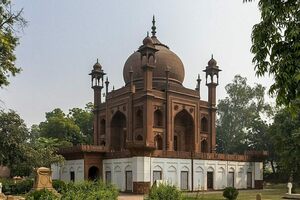John Hessing’s Tomb in Agra, India

John Hessing was a Dutch traveler turned army officer who served the Scindia Marathas in Agra at the turn of the 19th-century. He was eventually in charge of defending Agra Fort and during a battle with the British in 1803, he was killed. Just as the original Taj Mahal was built as a symbol of love by emperor Shah Jahan for his wife, this monument was commissioned by Hessing’s widow, Ann, in his memory.
This smaller version of the Taj Mahal mirrors much of the same design as its predecessor. Visitors can see typical Mughal-style engravings, arches, domes, and symmetrical designs. Unlike the original, however, the structure is much tighter with a simple square layout. Hessing’s tomb was designed using red sandstone rather than white marble. At the entrance to the tomb are two inscriptions in Persian: one expressing his wife’s grief and the other marking the year of his death.
Hessing’s tomb reflects the interactions of different cultures that occurred prior to British imperial rule. Hessing was incorporated into the local Hindu kingdom and given a high position of authority to defend the kingdom against European powers.
The monument, housed in a Catholic cemetery, incorporates common elements of Islamic tomb architecture.





